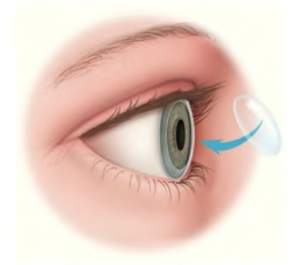Corneal Transplants
A Closer Look
New Windows for Sight
Ophthalmologists (Eye M.D.s) perform more than 40,000 corneal transplants each year in the United States. Of all transplant surgery done today — including heart, lung, and kidney — corneal transplants are the most common and successful.
What is the Cornea?
The cornea is the clear front window of the eye that covers the colored iris and the round pupil. Light is focused while passing through the cornea so we can see.
How Can An Unhealthy Cornea Affect Vision?
If the cornea is injured, it may become swollen or scarred, and its smoothness and clarity may be lost. Scars, swelling or an irregular shape can cause the cornea to scatter or distort light, resulting in glare or blurred vision.
A corneal transplant is needed if:
- Vision cannot be corrected satisfactorily with eyeglasses or contact lenses
- Painful swelling cannot be relieved by medications or special contact lenses
What Conditions May Cause the Need for a Corneal Transplant?
- Corneal failure after another eye surgery, such as cataract surgery
- Keratoconus, a steep curving of the cornea
- Hereditary corneal failure, such as Fuchs' dystrophy
- Scarring after infections, especially after herpes
- Rejection after a first corneal transplant
- Scarring after injury
What Happens if You Decide to Have a Corneal Transplant?
Before Surgery
Once you and your ophthalmologist decide you need a corneal transplant, you will be scheduled for surgery. Most of the time a donor cornea will be available for your surgery, but sometimes the surgery will need to be postponed if a suitable donor cornea is not available, or if your surgeon has special requirements for donor tissue.
Before a cornea is released for transplant, the eye bank tests the human donor for the viruses that cause hepatitis, AIDS and other potentially infectious diseases. The cornea is also carefully checked for clarity.
Your ophthalmologist may request that you have a physical examination and other special tests. If you usually take medications, ask your doctor if you should continue using them.
The Day of Surgery
Surgery is often done on an outpatient basis. You may be asked to skip breakfast, depending on the time of your surgery. Once you arrive for surgery, you will be given eyedrops and perhaps a sedative to help you relax.
Either local or general anesthesia is used, depending on your age, medical condition and eye disease. You will not see the surgery while it is happening. Your eye will be held open with a lid speculum or another method.
The Operation

The eyelids are gently opened. Your ophthalmologist will view your eye through a microscope and measure your eye for the corneal transplant.
The diseased or injured cornea is carefully removed from the eye. Any necessary additional work within the eye, such as removal of a cataract, is completed. Then the clear donor cornea is sewn into place.
When the operation is over, your doctor will usually place a shield over your eye.
After Surgery
If you are an outpatient, you may go home after a short stay in the recovery area. You should plan to have someone drive you home. An examination at the doctor's office will be scheduled for the following day.
You will need to:
- Use the eyedrops as prescribed
- Be careful not to rub or press on your eye
- Use over-the-counter pain medicine, if necessary
- Continue normal daily activities but avoid strenuous exercise or activities until cleared to do so by your doctor
- Wear eyeglasses or an eye shield for protection, as advised by your doctor
- Ask your doctor when you can start driving again
- Call your doctor if you have any questions about your home-care instructions
Your ophthalmologist will decide when to remove the stitches, depending upon the health of your eye and rate of healing. Full recovery of vision after a corneal transplant can take up to one year or longer. After a few months or a year, sutures may be removed, which sometimes improves vision. Often, stitches are left in place permanently.
What Complications Can Occur?
Corneal transplants are rejected 5 percent to 30 percent of the time. The rejected cornea clouds and vision deteriorates.
Most rejections, if treated promptly, can be stopped with minimal injury. Warning signs of rejection are:
- Persistent discomfort
- Light sensitivity
- Redness
- Change in vision
Any of these symptoms should be reported to your ophthalmologist immediately.
Other possible complications include:
- Infection
- Bleeding
- Swelling or detachment of the retina
- Glaucoma
All of these complications can be treated.
A corneal transplant can be repeated, usually with good results, but the overall rejection rates for repeated transplants are higher than for the first transplant.
Irregular curvature of the transplanted cornea (astigmatism) may slow the return of vision but can also be treated. Vision may continue to improve up to a year after surgery.
If the surgery is successful, other existing eye conditions, such as macular degeneration, glaucoma or diabetic retinopathy, may limit vision after surgery.
Even with such problems, a corneal transplant may still be worthwhile.
A successful corneal transplant requires care and attention on the part of both patient and physician. However, no other surgery has so much to offer when the unhealthy cornea is deeply scarred or swollen.
Corneal transplant surgery would not be possible without the thousands of generous donors and their families who have donated corneal tissue so that others may see.




